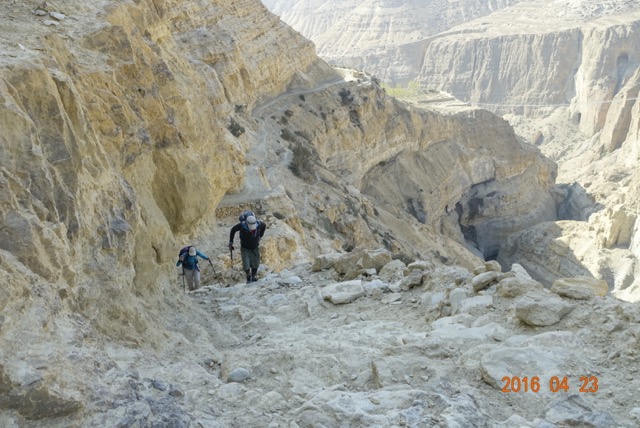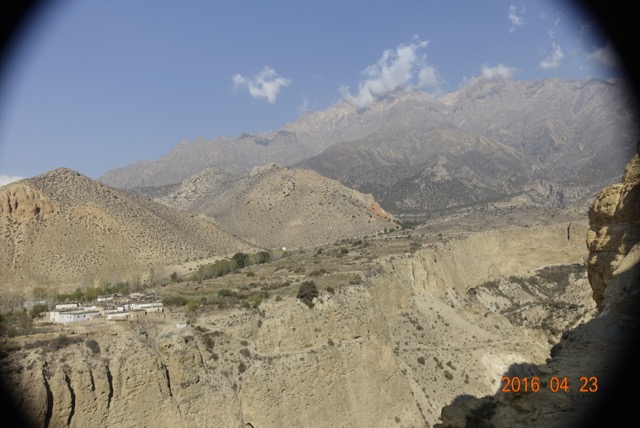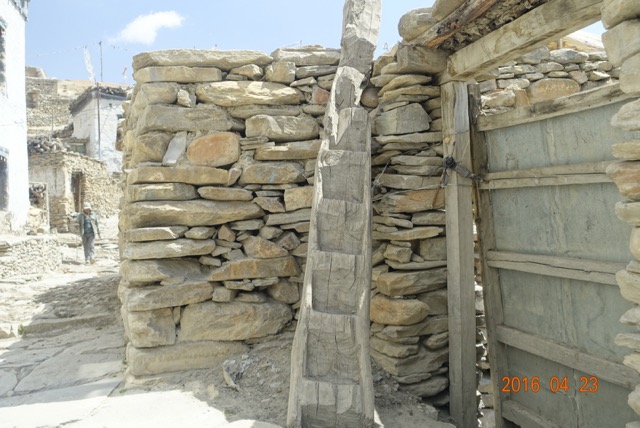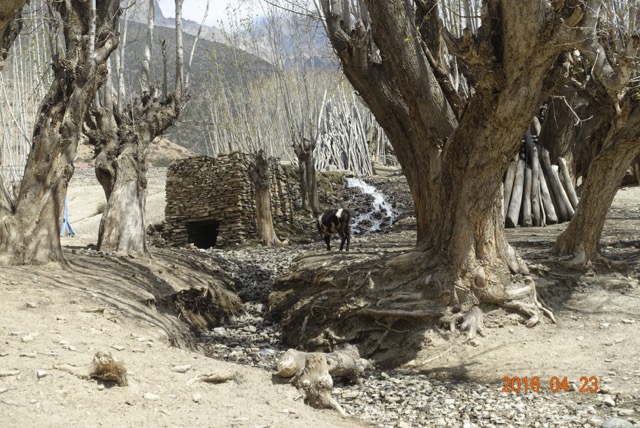After we freshened up – which consisted of taking off dusty hiking boots – we climbed down to the tea house dining room. Windowed on two sides, it overlooked the town, which slanted below us as it crowded to the edge of the cliff we’d just climbed up. A younger couple, speaking Spanish, were murmuring, heads together, over a book. They looked up, smiled, and we started trying to converse. Their English trumped our Spanish, although I did dredge up my decades old memories, dusted them off, and bridged the linguistic gap a bit.
They were finishing a two week jaunt to Lo Manthang and back. Eager to fill us in on what lay ahead, they referred to the book. I noticed the author, Michel Peissel. Like us, they’d picked up a copy of Mustang: The Forbidden Kingdom, to prepare for the adventure. Unlike us, they’d lugged it the entire 200 km of their trek, hang the 15 kg weight limit. They marveled at how prescient and accurate Peissel’s insight and descriptions were.
As we sopped up their knowledge of what lay ahead, a smiling Nepali strode in, trailing a younger man, possibly his apprentice. Turns out he is an architect, from Kathmandu, who is visiting Mustang to check on a boutique project, turning a monastery dormitory into a tourist lodge. He had a very cosmopolitan outlook, and we fell into a prolonged conversation about dragging his homeland into the modern world.
“So what exactly are you building?”
“We found in Dhakmar that many homes were being abandoned as the younger people move permanently into Pokhara or Kathmandu. At the same time, the tourists are increasing, and expecting better lodging than the kind you see here.”
“Even with the earthquake? I thought tourism was down.”
He dismissed that airily. “Just a blip. More will come – are coming. So we are taking those houses which are no longer occupied, and are starting to fall down from lack of proper maintenance, and gutting them to the foundations. Then we build the lodge on top, using the same local materials you see all around here.”
“You mean the river rocks, stucco, tree branches?”
“Precisely.” He proudly showed us pictures of what might be a modern, yet primitive looking ski lodge. “The problem we’re trying to solve is, how do you maintain beauty and function when all of a sudden you have to house and feed four times as many people?”
I reflected on the International Mountain Museum we’d toured in Pokhara. A small display of aerial photographs showed the alarming changes in the Kathmandu valley since 1962. After slow growth into the 80s, the past twenty years showed the valley being entirely filled in, seemingly overnight. I described this to him, and noted all the concrete box apartment structures, their instability in the earthquake, and the deafening traffic everywhere. “Yeah, how do you fight the ultimate concretiztion of the world?”
It appeared his answer, at least in Mustang, was to use natural stone instead of the concrete – real vs artificial rock. More time, more money involved, but at least the western tourists could pay for it.
The sun had set while we were talking. A full moon was about to ascend, but the cliffs were blocking its light for now. With no streetlights dampening its power, the moon’s glow just before its rise reminded me of a city hidden 20 or 30 miles away behind the mountains.
Chaim then rolled in, and began what was to become his evening ritual. First, he dropped a menu in front of us, and took our orders for both dinner and tomorrow’s breakfast. Then he reviewed tomorrow’s trek, and asked when we wanted to leave. Every day, the conclusion would be the same: to spend as little time as possible in the afternoon wind, we should start as early as possible in the morning. Which for Chaim, apparently, meant 7:30-8 AM.
So off we went the next morning, into a brightening, cloudless day. This day would prove one of the toughest – maybe the hardest, as we were still early into the rhythm of the road. 11 miles in 5:15 of moving time, with an elevation gain of 4600’.
The first twenty minutes out of town took us up a track carved into a cliffside. Rocky steps, shaded by the escarpment, stretched on ahead. Across the canyon, the isolated village of Ghyakar clung to a sheer face. On the north side of town, a singletrack path led down into the depths.
Chaim pointed this out. “That’s how people used to travel out of Ghyakar. Now they have a bridge.” Craning our necks behind us, we could pick out a narrow, impossibly long suspension structure leading from our route over the river below, into town. Either way looked pretty forbidding to me.
While it seemed forever, it took us less than 30 minutes to crest Taklam La (Pass) at 3624 meters – a rise of 750’. We were greeted by the soon-to-be familiar duo of a rock pile – ritual requires tossing a rock upon arriving at the top – and flapping tattered prayer flags.
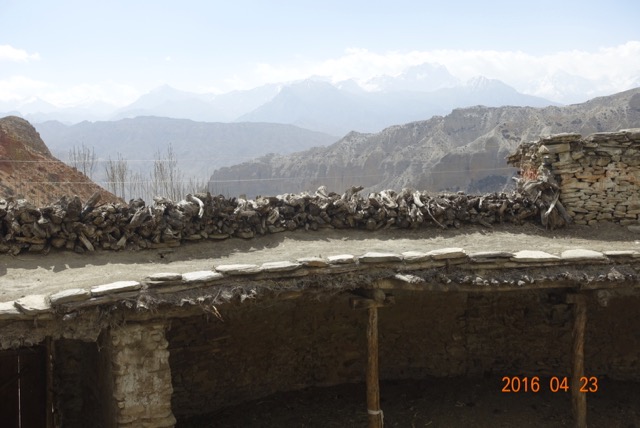 After a short stop for tea at Samar (elevation equal to the “top of the Burn”, 11,700’), we tackled another rise to lunch at Benha. While the food was forgettable, the bathroom was not. Mustangi dwellings are surrounded by a surfeit of scenery, so why not take advantage of it? The window over the squatting hole looked back to the Himalayan crest, just another ho-hum sight for the locals, but a recurring jaw-dropper for me.
After a short stop for tea at Samar (elevation equal to the “top of the Burn”, 11,700’), we tackled another rise to lunch at Benha. While the food was forgettable, the bathroom was not. Mustangi dwellings are surrounded by a surfeit of scenery, so why not take advantage of it? The window over the squatting hole looked back to the Himalayan crest, just another ho-hum sight for the locals, but a recurring jaw-dropper for me.
Walking out of town, I ticked off one of my “must-sees”. Peissel had always been taking a “tree ladder” up to the second and third stories, where the family and guest rooms invariably sit, above the animals’ quarters on the first. He never described them, so I was thrilled when I realised they are actually ladders carved out of a tree. Sturdy trunks are a rare commodity now, as the locals continually top their woods, leaving narrow branches jutting up from stout trunks. The wood is then piled along the upper eaves, to dry and be retrieved for fires. The past several years, cooking and heating oil has come into vogue, but the price must be too much for Mustangis, as all of the tea house kitchens featured a cast iron wood stove, doubling as furnace and cooking center.
The afternoon turned windy, and as we climbed even higher, into the cold. Clouds appeared as we descended into Ghiling (Geling). Widely scattered snowflakes started dropping on the track. Past the desolate entrance chorten, Chaim approached a single-story house, knocked, and got no answer. He pulled out his cell phone, but it was a half hour wait in the darkening evening before the proprietress appeared. Entering, we found an ceiling open in the middle to let smoke out, with guest room surrounding this interior courtyard. After dropping off our gear, I stepped outside, for another look at the developing alpenglow. Instead, I got a surprise visit from a few locals. As I gawked at the stark scenery, several of the town cows ambled over to the porch, and stood mooing, like cats asking for food.

